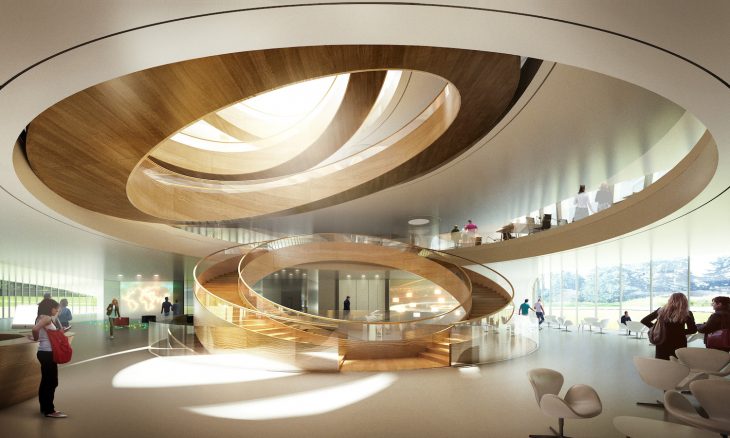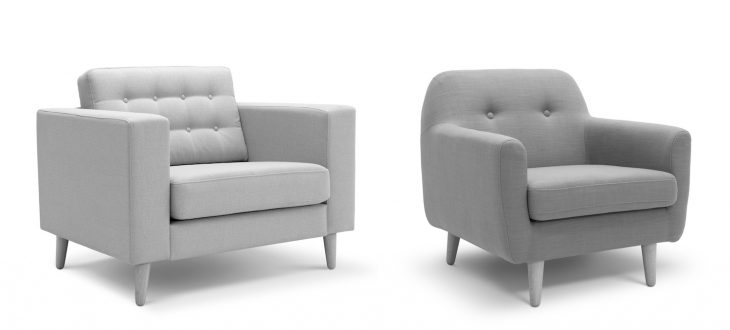Can developing spaces and furnishings dominated by curved contours improve the emotional well-being of a building’s occupants?

As a professional involved in workplace design, what do you believe should be the single most important goal of a physical work environment?
If you answered to make people happy, then you’re on to something.
Why is personal happiness so critical? Because when people are happy, they are more productive, more creative, experience less absenteeism and job turnover, and get along better with their peers and employers than when they are dissatisfied.
What many industry professionals would like to know, of course, is how to achieve this often elusive and difficult to define objective through the medium of design.
Here’s one technique that I can offer you: develop spaces and furnishings dominated by curved contours, rather than straight.
I offer this prescription not as a matter of opinion or personal taste, but because a considerable body of scientific evidence suggests that applying such a formal strategy can improve the emotional well-being of a building’s occupants.
Shape, Space, and Happiness
If you want to know what makes people happy, just ask them.
In 2012 a pair of researchers from Oregon State University ran an experiment in which over 100 subjects looked at four computer-generated perspectives of a furniture grouping consisting of a sofa, one or two lounge chairs, a pair of side tables, a lamp, a coffee table, and an area rug.
Two of the renderings contained furnishings that were predominantly curved in outline and detail. The other two showed pieces characterized by straight lines and squared-off shapes, similar to the contrast between the pieces illustrated below.

The researchers took steps to dilute the effects of any variables other than the form factor. For instance, the renderings were printed in grayscale to eliminate the impact of color. Artwork was absent from the walls, while the furnishings lacked decorative embellishments. From a style standpoint, the prevailing aesthetic could be charitably categorized as Comfortably Generic Modern.
The surrounding architectural context was similarly abstract and undefined. It was virtually impossible to determine whether the groupings were located in an office sitting area, a hotel lobby, doctor’s waiting room, residence, or other type of environment.
Subjects viewed both sets of images and were asked to rate them according to how pleasing they found their contents, how much time they would want to spend in the pictured environments, and how sociable the setting made them feel.
The results of the exercise were conclusive: rounded beat rectilinear by every measure.
Now, why would our innate preference for the sinuous over the straight manifest itself in positive aesthetic experiences, improved well-being, and a heightened sense of communality?
To answer that question, ask yourself another: How often have you cut yourself with a spoon?
Most likely never.
Now count the times you have hurt yourself with a knife or razor.
Probably more than once.
Given the relative likelihood of the two outcomes, what do you think happens to your mental state when you come in close proximity to an object with sharp edges or pointed corners? It enters into an elevated state of alert. Not quite overt panic, but enough to prompt your brain to raise your stress levels, sharpen your attention, and inject an element of caution if not fear into your thinking.

Now, partly this reaction is the result of learned experience. But partly it is the result of human beings being innately conditioned to feel more comfortable and relaxed at the sight of curved contour things than at straight things, regardless of whether or not they present a literal threat to their well-being.
Why did Mother Nature endow us with this response mechanism? Presumably to ensure survival back in our caveman days, when straight-edged and pointy objects (jagged rock outlines, pointed tree branches or tusks, rows of animal teeth) really did constitute a clear and present danger, while rounded, soft, and mutable shapes (a newborn baby, foliage) generally signaled safety and sustainability. These impulses influence our mental state to this very day, to where we remain psychologically at greater ease with curved contour objects than with hard-edged ones.
Several brain imaging studies confirm these intrinsic preferences. One investigation discovered that our amygdala—the region of the brain responsible for processing fear—jumps in activity at the sight of everyday objects formed from flat planes and sharp angles. A second study found that our comfort with curves extends to shaping interior space as a whole.
As in the 2012 experiment I described above, the team behind this latter study pitted images of predominantly curved contour interiors against spaces with a rectilinear character—picture Karim Rashid versus Mies van der Rohe—to determine whether differences of morphology made any difference in the subjects’ assessment of their aesthetic qualities. Indeed they did: subjects judged the curvilinear environments the more beautiful of the two by a substantial margin. Moreover, using the fMRI scans, researchers were able to trace the source of these judgments to the section of the brain responsive to reward, aesthetic appreciation, and emotion. Beauty being a nearly universal source of happiness, it can be reasonably inferred that the more beautiful a space is perceived to be, the happier and more content its occupants.

Corners and Curves in Feng Shui
Our attraction to curved contour over straight forms is one case where the vernacular wisdom of traditional practice closely aligns with modern scientific research.
For instance, the principles of feng shui generally counsel against having exposed external corners in an interior environment that might cause physical harm if bumped into, such as a rectangular glass-topped coffee table or poorly placed countertop. Practical advice, to be sure. But the admonition goes beyond mere pragmatics to further recommend against installing an object such as a chandelier with spiky ends, even though it is unlikely an occupant will ever make physical contact with the piece.
Adherents of feng shui consider internal corners to be equally problematic, advising that these negative spaces be concealed by a piece of furniture or plant material to mask their “cutting” energy.
Architect Thomas Heatherwick’s floor plan for a school in Singapore carries the principles of feng shui as well as findings in environmental psychology to their logical end, eliminating nearly all straight planes, right-angled internal corners, and rectilinear furnishings (note in particular the exclusive use of circular tables, a subject I explore elsewhere in this publication).
Does purely curvilinear form guarantee happiness? Of course not. Multiple factors contribute to the success or failure of a workplace environment, whether cultural or design-related, practical or intangible, human or material. Nor is roundedness necessarily a quality to be ruthlessly pursued to the exclusion of all else; in fact, followers of feng shui believe an equilibrium between the yin and yang of flat and curved elements is desirable in constructed settings. Still, both scientific and pre-modern conceptions of space and surface point to the same conclusion: strictly going straight may be injurious to your happiness.
This article is adapted from the author’s book My Creative Space: How to Design Your Home to Stimulate Ideas and Spark Innovation (Skyhorse, October 2019).



This is very interesting and probably not something that I would have thought about. I can see how round can be better received than rectangular objects with corners. What great information.
Now look it here the great online puzzle game Play free mahjong connect online now just connected here this visit and learn more about.
You gave tremendous positive points there. I did a search on the topic and found most peoples will agree with your blog.